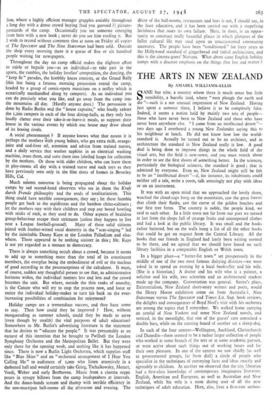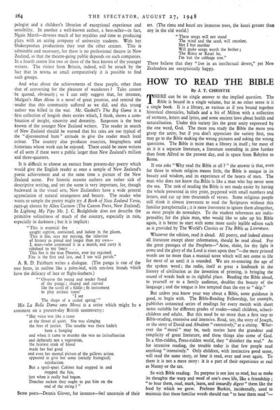THE ARTS IN NEW ZEALAND
By AMABEL WILLIAMS-ELLIS
SANE but trite, a country where there is much sense but little sensibility, a bucolic land, where " men plough the earth and die "—such is a not unusual impression of New Zealand. Having just spent a summer there, I believe it to be completely false. Indeed, it seems a notion held by mainly two sets of people— those who have never been to New Zealand and those who have never been anywhere else. " I come from an intellectual desert"— two days ago I overheard a young New Zealander saying this to his neighbour at lunch. He did not know how low the world- standard is. Actually he turned out to be an architect, and in architecture the standard in New Zealand really is low. A good deal is being done to improve things in the whole field of the visual arts, but the field is new-sown, and you must search about in order to see the first shoots of something better. In the sciences, particularly the biological sciences, the standard is good ; that is admitted by everyone. Even so, New Zealand might still be felt to be an " intellectual desert "—if, for instance, its inhabitants could neither tell a tale, write a poem, talk amusingly nor play with ideas or on an instrument.
It was with an open mind that we approached the lovely shore, watched the cloud-caps hang on the mountains, saw the great forests that climb their flanks, saw the curve of the golden beaches and our first tree ferns. The country is noble, the people kind, we said to each other. In a little town not far from our port we turned at last from the shops full of strange fruits and uncouponed clothes and had a look at the public library. It was small and the books rather battered, but on the walls hung a list of all the other books that could be got on request from the Central Library. All the books that our friends in England had lately been writing seemed to be there, and we agreed that we should have found no such library facilities in a comparable English or Welsh town.
In a bigger place—a " butter-fat town" set prosperously in the middle of one of the two most famous dairying districts—we were asked in to spend an evening by a local bookseller and his wife. (She is a historian.) A doctor and his wife who is a painter, a solicitor and his wife, two scientists and an architectural student made up the company. Conversation was general. Sartre's plays, Existentialism, New Zealand short-story writers and poets, would the Henry Moore exhibition come on from Australia ?, New Statesman versus The Spectator and Times Lit. Sup. book reviews, the delights and consequences of Boyd Neel's visit with his orchestra are among the topics that I remember. We walked home carrying an armful of New Yorkers and some New Zealand novels, and noticed, in the moonlight, that one of the guests' cars contained a double bass, while on the running board of another sat a sheep-dog.
In each of the four centres—Wellington, Auckland, Christchurch and Dunedin—there seemed to be a rather larger collection of people who worked at some branch of the arts or at some academic pursuit, or were active about such things out of working hours and for their own pleasure. In one of the centres we saw chiefly (as well as governmental groups, far from dull) a circle of people who specialise in the techniques of conveying facts and ideas exactly and agreeably to children. At another we observed that the city librarian had a first-class knowledge of contemporary imaginative literature, English, American and European, as well as Australian and New Zealand, while his wife is a most daring user of all the new techniques of adult education. Here, also, lives a first-rate anthro-
• pologist and a children's librarian of exceptional experience and 'sensibility. In another a well-known author, a best-seller—in fact, Ngaio Marsh—devotes much of her royalties and time to producing plays with an acting company of university students. With her Shakespearian productions they tour the other centres. This is admirable and necessary, for there is no professional theatre in New Zealand, so that the theatre-going public depends on such companies. In a fourth centre live two or three of the best known of the younger writers. The visitor from Britain, indeed, will be struck by the fact that in towns so small comparatively it is possible to find such groups.
And what about the achievements of these people, other than • that of conversing for the pleasure of wanderers ? Tales cannot be quoted, obviously ; so I can only suggest that, for instance, . Mulgan's Man Alone is a novel of great promise, and remind the reader that this community suffered as we did, and this young author was killed in the war. Mr. Gaskell's The Big Game is a first collection of longish short stories which, I think, shows a com- bination of insight, sincerity and dexterity. Sargesson is the best known of the younger New Zealand writers. The reader in search of New Zealand should be warned that his tales are too typical of the " discontented bum " attitude to give the reader much local colour. The country also produces essayists, biographers and historians whose work can be enjoyed. There could be more writers of all sorts if there were a public larger than New Zealand's million and three-quarters.
It is difficult to choose an extract from present-day poetry which would give the English reader at once a sample of New Zealand's poetic achievement and at the same time a picture of the New Zealand scene. For historic reasons authors are rather sick of • descriptive writing, and yet the scene is very important, for, though backward in the visual arts, New Zealanders have a wide general appreciation of natural strangeness and beauty. The reader who wants to sample the poetry might try A Book of New Zealand Verse, 1925-45 chosen by Allen Curnow (The Caxton Press, New Zealand). In Lighting My Pipe Mr. J. C. Bealglehole does not describe the primitive solitariness of much of the country, especially in rain, especially in darkness ; but it is implicit : " This is essential fire caught captive, contained, and isolate in the gloom. This is fire, says my musing, the inheritor of history as proud and longer than my own— I, man—who command it in a match, and carry it subdued to my fancy . .
This fire is the true Phoenix, ever joy regained. Fire is the first and last, and I too will perish."
A. R. D. Fairburn writes a dialogue. (The punga is one of the tree ferns, in outline like a palm-leaf, with ten-foot fronds which have the delicacy of lace or flight-feathers.) "' Observe the young and tender frond of the punga ; shaped and curved like the scroll of a fiddle ; fit instrument to play archaic tunes' `I see The shape of a coiled spring.'"
His La Belle Dame sans Merci is a satire which might be a
comment on a present-day British controversy : "Her voice was like a razor at the throat of quiet. She was slanging the foes of justice. The trouble was there hadn't been a hanging and when it came to murder she was no latitudinarian and definitely not a vegetarian, the faintest stink of blood made her feel good and even her mental picture of the gallows action appeared to give her some (strictly biological) satisfaction.
But a spoil-sport Cabinet had stepped in and stopped the fun, just when it really had begun.
Doncher reckon they ought to put him on the end of the string ? "
Some poets—Dennis Glover, for instance—feel uncertain of their
art. (The rimu and kauri are immense trees, the kauri greater than any in the old world.)
" These songs will not stand
The wind and the sand, will smother.
Not I but another
Will make songs worth the bother ; The Rimu or Kauri he, I'm but the cabbage tree."
These believe that they "live in an intellectual desert," yet New Zealanders are exceptionally happy.



































 Previous page
Previous page